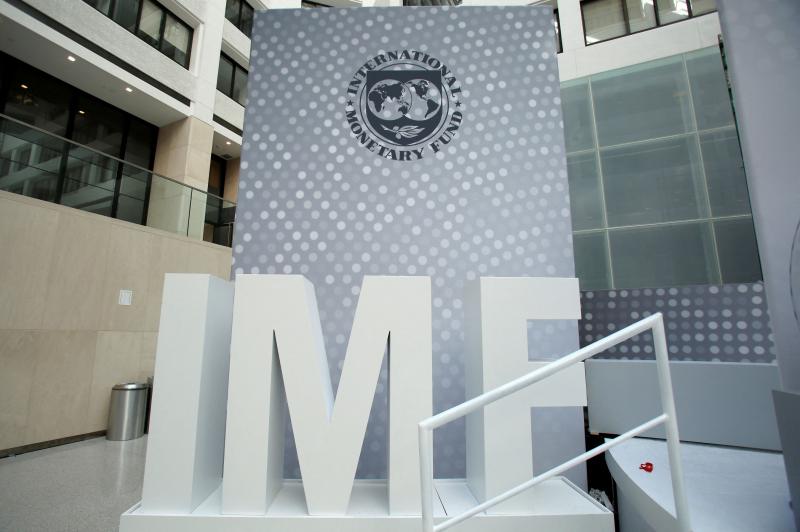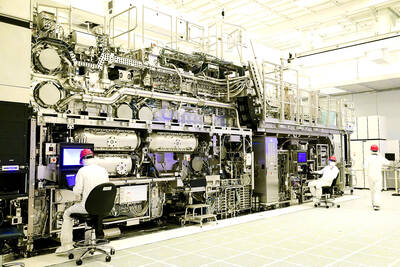The IMF boosted its growth forecast for Asia this year, reflecting a rosier outlook for the region’s two largest economies and flagging a possible upward revision in its outlook for China.
Asia is set to expand 4.5 percent this year from the prior year, 0.3 percentage points higher than the October regional outlook but a slowdown from last year’s 5 percent pace, according to the IMF report on Tuesday.
The IMF raised its forecast for Taiwan’s GDP growth for this year to 3.1 percent, up 0.1 percentage points from its October estimate and the highest among advanced economies in Asia.

Photo: Reuters
The IMF cut its projection for Taiwan's economy next year by 0.1 percentage points to 2.7 percent.
The latest data has taken into account the higher forecast for India published earlier this month and China’s pace, on the back of expectations that government stimulus will boost growth. On China, the IMF said first-quarter growth came in stronger than expected on robust exports and manufacturing demand, which may prompt another upward revision.
“Global disinflation and the prospect of lower central bank interest rates have made a soft landing more likely, hence risks to the near-term outlook are now broadly balanced,” IMF’s Asia and Pacific department director Krishna Srinivasan wrote in a blog post.
China’s central government has ramped up spending this year to support an economy still reeling from a weakened property sector and to propel growth to its target near 5 percent this year. In India, the government ramped up capital spending by a third for this year, the third year in a row.
China’s real GDP is seen expanding 4.6 percent this year from the prior year, and India to rise 6.8 percent this year, the IMF said. Officials left next year's regional outlook unchanged at a 4.3 percent advance.
Several risks remain, the IMF said. Chief among them is a long-term property sector downturn in China, which would weaken demand and prolong deflation. Other challenges include growing fiscal deficits and risks to trade from US-China tensions.
Officials also warned Asian nations of pinning too much on expectations for the US Federal Reserve’s path when deciding their own monetary policy. Indonesia this month unexpectedly raised interest rates to address a currency walloped by a strengthening US dollar. Southeast Asia’s largest economy is among many countries in the region contending with currency depreciation as the prospects of early Fed rate cuts wane.
While following the Fed “could limit exchange rate volatility” but “it risks that central banks would fall behind (or move ahead of) the curve and destabilize inflation expectations,” Srinivasan wrote.
Additional reporting by staff writer

ASML Holding NV’s new advanced chip machines have a daunting price tag, said Taiwan Semiconductor Manufacturing Co (TSMC, 台積電), one of the Dutch company’s biggest clients. “The cost is very high,” TSMC senior vice president Kevin Zhang (張曉強) said at a technology symposium in Amsterdam on Tuesday, referring to ASML’s latest system known as high-NA extreme ultraviolet (EUV). “I like the high-NA EUV’s capability, but I don’t like the sticker price,” Zhang said. ASML’s new chip machine can imprint semiconductors with lines that are just 8 nanometers thick — 1.7 times smaller than the previous generation. The machines cost 350 million euros (US$378 million)

EXPLOSION: A driver who was transporting waste material from the site was hit by a blunt object after an uncontrolled pressure release and thrown 6m from the truck Taiwan Semiconductor Manufacturing Co (TSMC, 台積電) said yesterday there was no damage to its facilities after an incident at its Arizona factory construction site where a waste disposal truck driver was transported to hospital. Firefighters responded to an explosion on Wednesday afternoon at the TSMC plant in Phoenix, the Arizona Republic reported, citing the local fire department. Cesar Anguiano-Guitron, 41, was transporting waste material from the project site and stopped to inspect the tank when he was made aware of a potential problem, a police report seen by Bloomberg News showed. Following an “uncontrolled pressure release,” he was hit by a blunt

Quanta Computer Inc (廣達), which makes servers and laptop computers on a contract basis, yesterday said it expects artificial intelligence (AI) devices to bring explosive growth to Taiwan’s electronics industry, as AI applications are starting to run on edge devices such as AI PCs. Taiwanese electronics manufacturers such as chipmakers, component suppliers and hardware assemblers are likely to benefit from a rapid uptake of AI applications, Mike Yang (楊麒令), president of Quanta Cloud Technology Inc (雲達科技), a server manufacturing arm of Quanta, told reporters on the sidelines of a technology forum in Taipei yesterday. “I believe the growth potential is promising once

RETALIATION: Beijing is investigating Taiwan, the EU, the US and Japan for dumping, following probes of its market, as well as tariff hikes on its imports The Chinese Ministry of Commerce yesterday said it had launched a dumping investigation into imports of an important engineering chemical from Taiwan, the EU, the US and Japan. It would probe imports of polyoxymethylene copolymer, a thermoplastic used in many precision parts used in phones, auto parts and medical equipment, the Chinese commerce ministry said. The ministry is reviewing materials provided by six Chinese companies that applied for assistance on behalf of the industry on April 22, it said. The probe will target polyformaldehyde copolymer imported from suppliers in the EU, the US, Taiwan and Japan last year, and will assess any damage